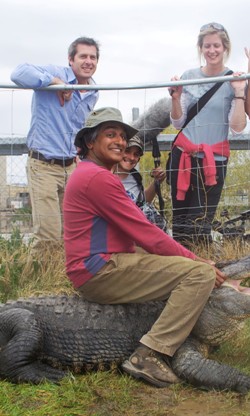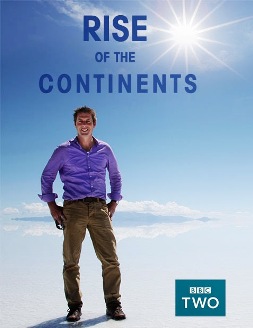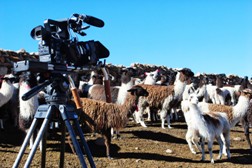 Producer and geologist Helen Quinn (left, on location with Iain Stewart ) considers how the theory of plate tectonics has helped put geoscience on TV
Producer and geologist Helen Quinn (left, on location with Iain Stewart ) considers how the theory of plate tectonics has helped put geoscience on TV
“Why is it relevant?”
This is the question we, as TV producers, get asked most often when pitching new ideas to programme commissioners. Having previously completed a PhD in science and dipped my toe into the world of geological research, I used to find this question difficult. Of course it’s relevant, I was thinking: science is everywhere, science is how the world works. Of course this story needs to be told! But with a little more experience of working on science documentaries, I have come to understand that this is actually the most important question - and it is my job to find a way of answering it.
After completing my PhD I decided to step out of research and into science communication. What I didn’t realise was what I wanted to do was tell stories. Storytelling is something we all do, a way of communication unique to humans, it has allowed us to convey events and ideas throughout history in an understandable and entertaining way. Stories are our way of making sense of the world, of finding our place within it. But some stories can be harder to tell than others, and geology, with its vast, unimaginable timescales often finds its way into this difficult category. But, when the 50th anniversary of Vine and Matthews’s momentous publication on sea floor spreading and the theory of plate tectonics came around, BBC programme commissioners believed geological stories could make interesting television and thus The Rise of the Continents was born.
Storytelling is something we all do, a way of communication unique to humans, it has allowed us to convey events and ideas throughout history in an understandable and entertaining way. Stories are our way of making sense of the world, of finding our place within it. But some stories can be harder to tell than others, and geology, with its vast, unimaginable timescales often finds its way into this difficult category. But, when the 50th anniversary of Vine and Matthews’s momentous publication on sea floor spreading and the theory of plate tectonics came around, BBC programme commissioners believed geological stories could make interesting television and thus The Rise of the Continents was born.
UNASHAMED
The series was completely and unashamedly a geological story with its roots in the theory of plate tectonics. It was broadcast earlier this year on BBC 2, presented by the University of Plymouth geologist, Professor Iain Stewart.
It aimed to te ll the story of how our continents came to be as they are today, and the journeys they made to get there. From the time of the last giant supercontinent Pangea, it told how continental movements have helped build the world around us, contributed to our shared human history and influenced
ll the story of how our continents came to be as they are today, and the journeys they made to get there. From the time of the last giant supercontinent Pangea, it told how continental movements have helped build the world around us, contributed to our shared human history and influenced
the plants and animals with whom we share our planet. ts underlying story was how all this was brought together under the grand unifying theory of plate tectonics. The theory, as significant as the discovery of DNA in the biological sciences, brought together years of research allowing almost every geological phenomenon to be explained and connected. For us, half a century later, the theory had the added bonus of helping us build a narrative for our documentaries.
The theory of plate tectonics allowed us to navigate a simplified and understandable pathway through the science. And because it was so momentous in the history of geosciences, parts of this theory are now recognisable to non-experts. The fact that the continents look like parts of a giant jigsaw whose pieces have been strewn across the globe, resonates with many people, and for us this was a good starting point. Each programme in the series covered a major continental landmass or groupings of major landmasses - Africa, The Americas, Australasia and Eurasia - and in terms of practicality we assigned a separate team to each. Initially, a director and a producer would get up to speed with the geology, making contact with experts and discovering new research. One of our biggest challenges was to get our heads around over 300 million years of geological history and think about how this could be condensed into an understandable and interesting, but also (crucially) visual hour of television.
PERSONAL
Early on, we decided we wanted Iain to take a more personal role in the documentary. We wanted the audience to buy into the idea that a geologist sees the world in a unique way.  As Series Producer, Zoe Heron explains: “We were aiming to translate what Iain was seeing when he looked at landscapes. As a geologist he didn’t just see a layer of rock in front of him, he saw a whole history open up before his eyes, his eyes took us away from the present and into a different world”. Through Iain we wanted to translate this geologist’s view of the world to our audience.
As Series Producer, Zoe Heron explains: “We were aiming to translate what Iain was seeing when he looked at landscapes. As a geologist he didn’t just see a layer of rock in front of him, he saw a whole history open up before his eyes, his eyes took us away from the present and into a different world”. Through Iain we wanted to translate this geologist’s view of the world to our audience.
To do this visually we created momens in the film where we used quick cuts and flashes of symbols or geological clues that helped decode the landscape that Iain was looking at. The aim was to convey the feeling of being inside a geologist’s mind, seeing the landscape through geological eyes and understanding how the micro structures made the macro structures.
As well as style, the content of each film needed to be carefully considered. With so much science to fit in, we were wary about overloading each film. We chose eight key moments in the history of each landmass, all of which moved us a little closer to answering our main question about how the continents came to be as they are today. We wanted things on the other side of the world to feel relevant to wherever you were, in the way in which the theory of plate tectonic brought everything together. (One of our more surprising connections was made at an alligator farm in Southern Colorado.)
SUPERCONTINENT
As part of the story of the American continent, we set out to describe when the continents very gradually transformed from the coal swamps characteristic of the Carboniferous, to the dry deserts of the Permian as the supercontinent Pangaea took shape. Amphibians could no longer thrive in this new landscape because of the very limited wetland areas in which to lay their eggs. Reptiles, ancestors of the crocodilian, began to dominate in Pangaea’s deserts, largely because of one key adaptation - internal fertilisation. Environmental change, brought about as a result of continental movement, became the catalyst for evolutionary change.
 As director Arif Nurmohamed recalls: “Internal fertilisation was a key turning point in our narrative and I wanted to tell this story with an energy that would illustrate this momentous change. Seeing these prehistoric-looking creatures in Colorado and realising that the way we reproduce as humans is linked back to Pangaea and the ancestors of those gators was incredible.” This story of environmental change, caused by huge continental movement over 200 million years ago linked geology into an evolutionary change and suddenly became very relevant to us.
As director Arif Nurmohamed recalls: “Internal fertilisation was a key turning point in our narrative and I wanted to tell this story with an energy that would illustrate this momentous change. Seeing these prehistoric-looking creatures in Colorado and realising that the way we reproduce as humans is linked back to Pangaea and the ancestors of those gators was incredible.” This story of environmental change, caused by huge continental movement over 200 million years ago linked geology into an evolutionary change and suddenly became very relevant to us.
EXCITE & INSPIRE
In producing a series of geological films, our role was to excite and inspire people about the world around us and the science within it. Vine and Matthews’ theory certainly influenced the way were able to tell our story. Because it so clearly brought everything together, explaining past and present geological activity and highlighting our connections around the world, I believe it helped us get that original commission to put geology on television.
I hope we got people talking about geology, and maybe even looking at the world with new eyes. Our films needed to resonate with the audience, whilst keeping a clear view of the science, we needed to entice, inform and entertain. By using the unifying theory of plate tectonics as our subject we were able to build a narrative through the science. And for us, even with geology, it all comes back to telling stories.
* Helen Quinn works in the science department at the BBC.